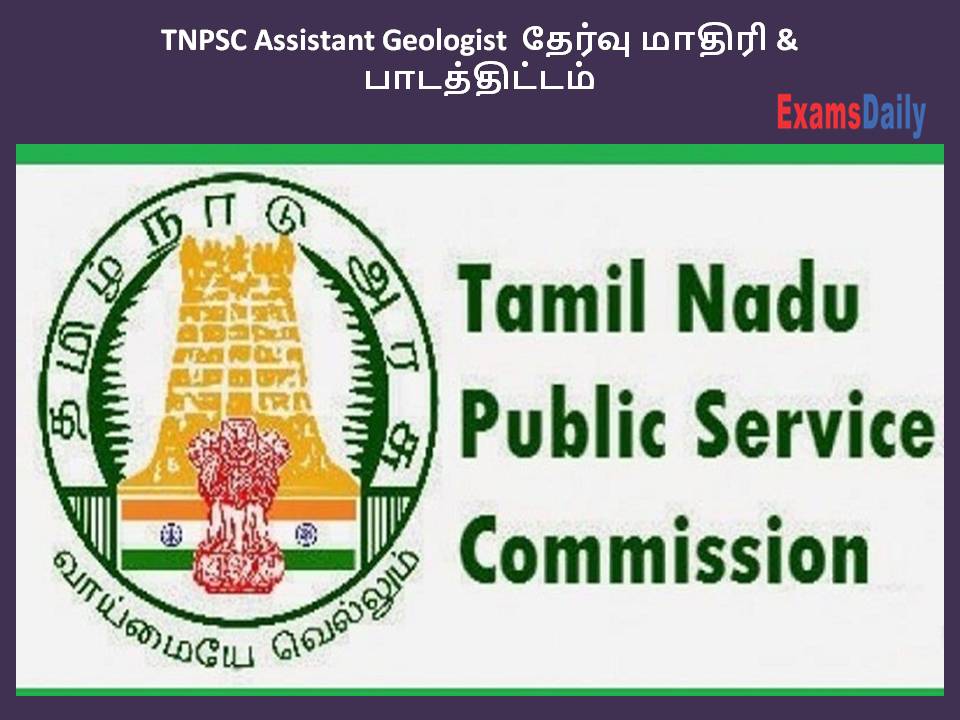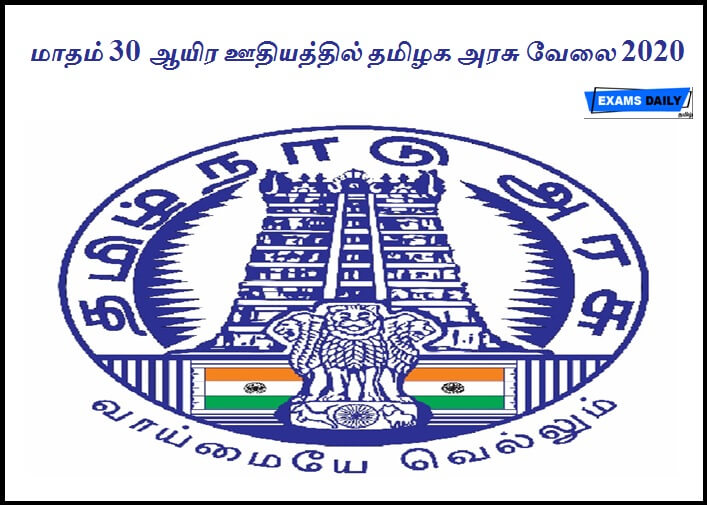TNPSC உதவி புவியியலாளர் தேர்வு மாதிரி & பாடத்திட்டம்!
தமிழ்நாடு அரசு பணியாளர் தேர்வாணையமானது Assistant Geologist பதவிக்கான தேர்வை நடத்த திட்டமிட்டுள்ளது. இப்பணிக்கு விண்ணப்பித்தவர்களுக்கான எழுத்து தேர்வானது 20.11.2021 முதல் 21.11.2021 வரை நடைபெற உள்ளது. மேலும் இத்தேர்வுக்கு தயாராகுபவர்களுக்கு உதவிடும் வகையில் இதற்கான பாட திட்டத்தினை கீழே வழங்கியுள்ளோம். அதன் மூலம் படித்து பயன்பெற வாழ்த்துகிறோம்.
Download Notification 2021 Pdf
TNPSC தேர்வு செயல்முறை :
- Written Examination
- Interview
TNPSC தேர்வு மாதிரி:
(A)(For the post of Assistant Geologist in Geology and Mining Department, Ground water wing of Public Works Department (post Graduate standard)
| Subject | Duration | Maximum Marks | Minimum Qualifying Marks for Selection | |
| SCs, SC(A)s, STs, MBC(V)s, MBCs and DNCs, MBCs, BCs and BCMs. | Others | |||
| PAPER I (200 Questions) (PG standard) Geology
(code No.240) |
3 Hours | 300 | 171 | 228 |
| PAPER II (100 Questions)
General Studies (Degree Standard) 75 Questions and Aptitude and Mental Ability -25 Questions |
2 Hours | 200 | ||
| Total | 570 | |||
(B) (For the post of Assistant Geologist in Agricultural Engineering Department) (Under Graduate standard)
| Subject | Duration | Maximum Marks | Minimum Qualifying Marks for Selection | |
| SCs, SC(A)s, STs, MBC(V), MBCs and DNCs, MBCs, BCs and BCMs. | Others | |||
| PAPER I (Subject Paper) (200 Questions) (Degree standard) Geology (code No.239) | 3 Hours | 300 | 171 | 228 |
| PAPER II (General Studies) (100 Questions) General Studies (Degree Standard)-75 Questions and Aptitude and Mental Ability Test-25 Questions | 2 Hours | 200 | ||
| Total | 570 | |||
TNPSC Assistant Geologist Syllabus 2021:
(U.G.DEGREE STANDRAD)
Paper-I Geology:
UNIT I – GENERAL GEOLOGY
Origin, Interior and Age of the Earth – Weathering – Types and products – Geological work of Wind, River, Sea and Groundwater – Volcanoes – Earthquakes – causes and effects – Seismic zonation – Richter Scale – Principles of Plate Tectonics – fundamental and geomorphology.
UNIT II – STRATIGRAPHY
Principles of Stratigraphy – Correlation – Geological Time Scale – General characteristics, descriptive and economic importance of Archean, Cuddapah, Vindhyan and Gondwana systems of Peninsular India -Cretaceous system of Tamil Nadu.
UNIT III – STRUCTURAL GEOLOGY
Folds – Faults – Joints – Unconformities – Recognition of overturned beds –Stress and strain relationship – Attitude of beds – Measurement of dip, apparent dip, strike using Cino and Brunton Compass .
UNIT IV – PALAEONTOLOGY
Fossils – Definitions, Conditions, mode of preservation, uses of Fossils – General morphology and classification of Graptolites, Mollusca, Coelenterata, Brachiopod, Trilobita, Echinoids and Foraminifera.
UNIT V – CRYSTALLOGRAPHY
Definition of crystals – Inter facial angles – Goniometer -Symmetry Elements – Study of Normal Classes of Isometric, Tetragonal, Hexagonal, Orthorhombic, Monoclinic and Triclinic systems – Twin crystals.
UNIT VI – MINERALOGY
Physical properties of minerals – Petrologcal Microscope and its parts, accessory plates and uses – optical properties – Isotropic and Anisotropic Minerals – Descriptive study of quartz and its varieties – Feldspar Group – Pyroxene Group – Amphibole Group – Mica Group – Garnet Group – Descriptive study of Calcite, Dolomite, Tourmaline, Topaz, Staurolite, Chlorite and Zircon.
UNIT VII – IGNEOUS PETROLOGY
Definition of magma – Composition and constitution of magma – Forms and structures of Igneous Rocks, Textures and Micro structures – classification of Igneous rocks – Bowen’s Reaction principle – Descriptive Study of Granite – Syenite – Diorite – Gabbro – Dolerite – Ultramafics (Dunite,Peridotite, Pyroxenite and Anorthosite) – Differentiation – Assimilation.
UNIT VIII – SEDIMENTARY AND METAMORPHIC PETROLOGY
Classification – Texture and structures of sedimentary rocks – Descriptive study of Residual, Clastic, Chemical and organic deposits – Metamorphism – Agents and kinds of metamorphism – classification of metamorphic rocks – Textures and structure – Different facies – Marble – Schist and Gneiss – Amphibolite – Granulite (Charnockite).
UNIT IX – ENONIMIC GEOLOGY I
Definition of Ore – Tenor – Gangue – Lindgren and Bateman’s classification of ore deposits – Ore forming processes – Magmatic concentration – Hydrothermal Process Oxidation and Supergene Enrichment – Evaporation – Sedimentation – Placer deposits. Important ores, their composition, physical properties, mode of occurrence, distribution in India and uses of Gold, Iron, Aluminium, Manganese, Copper, Magnesium and Led and Zinc – Lignite, Coal and Petroleum – their occurrence in India – Building Stones, their characters, distribution and mode of occurrence in India – Mineral Wealth of Tamil Nadu.
UNIT X – APPLIED GELOLOGY
Principles of Geological mapping – Field Techniques – Drilling methods – Borehole problems from borehole data – Geological investigation and conditions for dams, tunnels and roads – Landslides – Mining methods, role of geology – problems in mines including groundwater – Application of Remote sensing in Geology.







